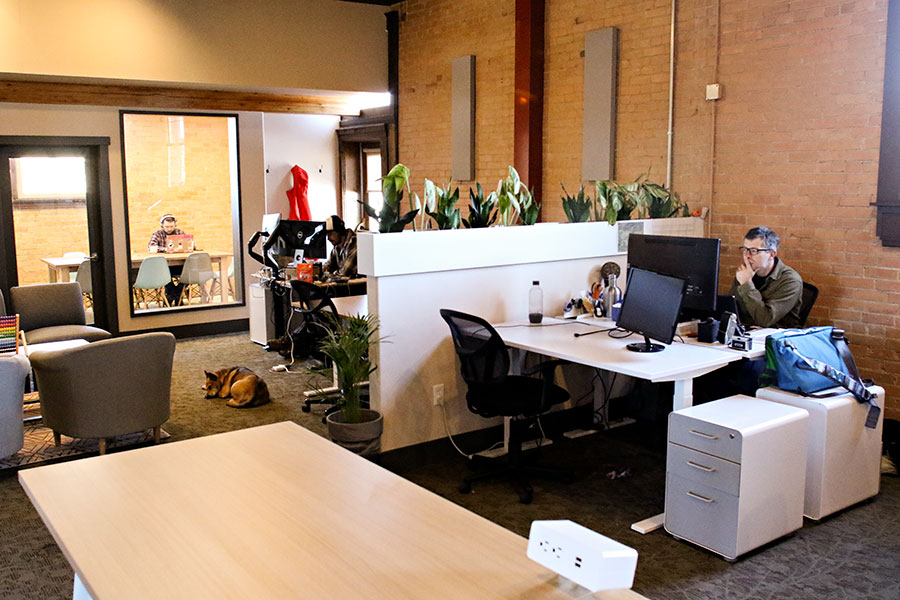The Rise of Remote Workers
More people across the country are working remotely, a trend that is especially pronounced in Montana
By Myers Reece
The 2017 Gallup “State of the American Workplace” revealed that 43 percent of the U.S. labor force worked remotely the prior year, defined as employees who spent at least part of their time working from a different location than their coworkers.
The report noted that not only were more people working remotely, they were increasingly doing it either full-time or nearly full-time, with almost one-third of those surveyed spending more than 80 percent of their time working remotely.
Montana reflects this trend, giving the word “remote” a literal sense, with a geography and demography that traditionally connote a degree of isolation. But in a plugged-in world that’s increasingly interconnected, and one in which employees of all stripes seek outdoor playgrounds, Montana is a logical remote worker stronghold.
Christina Quick Henderson, executive director of the Montana High Tech Business Alliance, says the state has the fourth-highest per-capita ratio of remote workers in the country, propelled by a number of economic, technological and social factors: high-speed internet connectivity and technological advancements opening up more opportunities, more workers emphasizing quality of lifestyle and flexibility of schedule, and more employers willing to incorporate remote employees, not to mention a burgeoning tech industry led by a string of successful startups.
An annual survey of tech companies by Henderson’s organization once again identified quality of lifestyle as the most attractive benefit of doing business in Montana.
“It’s the beauty of the landscape, the connectiveness to the outdoors, tightness to community, support for families,” Henderson said. “That’s a lot of the reason that people either want to stay in Montana and figure out a job scenario that will make it work for them or are wanting to move from Silicon Valley and other places to be here.”
Businesses like Basecamp Coworking, founded by Drew Fortner in downtown Whitefish, have emerged to accommodate this new workforce reality. Basecamp offers a range of drop-in desks, dedicated desks, private offices, conference rooms and other amenities for freelancers, remote workers and others who are seeking a workspace but don’t have their own office and prefer not to work from home.
Stacey Lujan, who rents a space at Basecamp, moved to Whitefish from Dallas two years ago, and she hasn’t skipped a beat running her social media marketing and branding business from Northwest Montana, first from her house and now at Basecamp, where she enjoys the camaraderie and exchange of ideas. Lujan regularly uses tools such as videoconferencing to engage with clients across the country.
“Gone are the days when you had to be right in front of your client in order to have an effective impact on their business,” Lujan said.
One desk over from Lujan is Derrick Coston, who works in business intelligence and data warehousing. There are limited local job opportunities for his skills, but working remotely has expanded the market nationwide and allowed him to land a position with a Texas-based firm, meaning he can do the work he wants in the place he loves.
“It’s really opened up the job market for me,” Coston said. “Locally businesses aren’t big enough to need a guy like me.”
Lech Naumovich, a restoration ecologist and the executive director of a nonprofit he founded in the Bay Area of California, regularly visits the sites of his organization’s California projects but is able to do much of his work from his Basecamp desk. In addition to outdoor amenities, Naumovich says other lifestyle benefits here include his kids walking from the bus stop to the library on their own, which wouldn’t have happened in Oakland.
Running an organization from a distance comes with challenges, which Naumovich is still learning how to navigate.
“It’s been a learning experience figuring out where we’re losing capacity and where we’re gaining it, i.e. not commuting an hour each way,” he said.
Naumovich, who is also a photographer, hopes to cultivate local relationships that ultimately lead to projects in the valley and says it’s crucial to remember that living and working here must include mutualistic symbiosis.
“In a place where you value the quality of life, you have to make sure you’re not taking away from it,” he said.
Connectivity benefits employees and employers alike, as people like Coston can work for employers in other states while entrepreneurs can run businesses from Montana, culling from a three-pronged labor market: hiring locally, attracting employees from elsewhere to move here and employing remote workers who continue to live out of state.
As Henderson puts it, technology has removed the “geographical constraints” that once created distance between Montana and the global economy.
“With technology,” she said, “we’re empowered to be able to work from anywhere.”